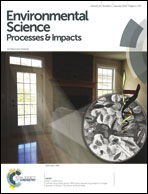Progress on understanding spatial and temporal variability of PM2.5 and its components in the Detroit Exposure and Aerosol Research Study (DEARS)†
Abstract
The Detroit Exposure and Aerosol Research Study (DEARS) measured personal exposures, ambient, residential indoor and residential outdoor concentrations of select PM2.5 aerosol components (SO4, NO3, Fe, Si, Ca, K, Mn, Pb, Zn, EC and OC) over a three year period (2004–2007). These events represented approximately 190 calendar days of monitoring which was performed in seven residential neighborhoods throughout Wayne County, MI. The selection of neighborhoods and participants for study inclusion was based upon an a priori hypothesis that each neighborhood represented a potentially distinct air quality scenario being influenced by both regional as well as local pollution sources. Daily (24 h integrated) measurement data were used to evaluate the spatial and temporal PM2.5 compositional variability of the personal, indoor and outdoor spatial settings as they related to a central ambient monitoring site (Allen Park). Many of the PM2.5 components were observed to have spatially different outdoor mass concentrations in matched neighborhood by neighborhood comparisons, with sulfate, OC, and NO3 being noted exceptions. Coefficient of divergence (COD) comparisons involving outdoor measures for Ca, Si, Fe, Zn, Pb, and EC revealed significant spatial variability. While concentrations of most components were lower indoors as compared to outdoor measures, K and Si indoor concentrations often reflected aerosol enrichment (indoor/outdoor ratios ≥ 1.2). Even when personal exposures were adjusted for day to day changes in ambient concentrations, certain components (Ca, Fe, Mn, Zn, among others) revealed a high degree of location-specific spatial variability suggesting the influences of personal activities and/or local source influences on total personal PM2.5 exposures. As a whole, findings indicate that reliance on a central ambient monitor as a surrogate for total personal and potentially even residential outdoor estimates of PM2.5 aerosol composition may provide an undesirable degree of exposure uncertainty for health-based risk estimates. The focus of this paper is on the spatial variability and uncertainty in using a central monitoring site to estimate exposures. Additional information concerning the DEARS can be found at http://www.epa.gov/DEARS/.


 Please wait while we load your content...
Please wait while we load your content...